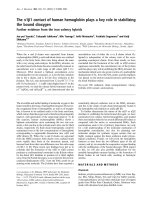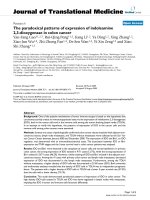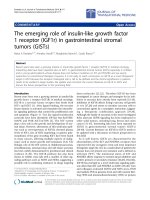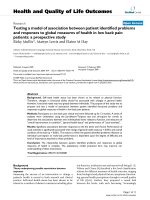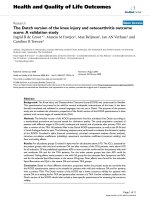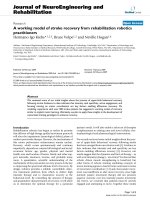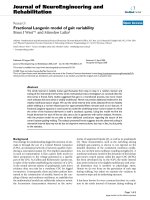báo cáo hóa học:" The hen model of human ovarian cancer develops anti-mesothelin autoantibodies in response to mesothelin expressing tumors" docx
Bạn đang xem bản rút gọn của tài liệu. Xem và tải ngay bản đầy đủ của tài liệu tại đây (800 KB, 9 trang )
RESEARCH Open Access
The hen model of human ovarian cancer
develops anti-mesothelin autoantibodies in
response to mesothelin expressing tumors
Yi Yu
1
, Seby L Edassery
1
, Animesh Barua
1,2,3
, Jacques S Abramowicz
2
, Janice M Bahr
4
, Ingegerd Hellstrom
5
and
Judith L Luborsky
1,2*
Abstract
Objective: Study of the hen immune system led to seminal contributions to basic immunological principles.
Recent studies of spontaneous ovarian cancer in the laying hen show strikingly similar tumor types and antigen
expression compared to human ovarian cancer, suggesting hens would be valuable for studies of tumor
immunology and pre-clinical vaccine development. Circulating mesothelin is a relatively specific marker for human
ovarian cancer and autoantibodies to mesothelin were reported. We hypothesized that hen tumors express
mesothelin and that circulating anti-mesothelin antibodies occur in response to tumors.
Methods: Mesothelin mRNA expression was analyzed by RT-PCR in hen ovarian tumors and normal ovaries.
Mesothelin protein expression was evaluated by immunohistochemistry (IHC) and two-dimensional SDS-PAGE
Western blots. Anti-mesothelin antibodies were assessed by immunoassay of sera from hens with normal ovaries
and with ovarian tumors.
Results: Significant mesothelin mRNA expression was observed in 57% (12/21) of hen ovarian tumors but not in
normal ovaries and was found predominantly in serous tumors as in human s. Mesotheli n protein was detected in
tumors with mesothelin mRNA by IHC and 2D Western blots, but not in normal ovaries or tumors without
mesothelin mRNA. Circulating anti-mesothelin antibodies occurred in 44% (n = 4/9) of hens with ovarian tumors
which express mesothelin mRNA and were not found in hens with tumors that did not express mesothelin (n = 0/5)
or normal ovaries (n = 0/5).
Conclusion: The results support the utility of the hen as a novel model for preclinical studies of mesothelin as a
biomarker and a target for immunotherapy.
Keywords: Mesothelin, Mesothelin antibodies, Ovarian Cancer, Hens, Animal Model
Introduction
Study of the hen immune system led to seminal contribu-
tions to basic immunological principles [1]. Recent stu-
dies of spontaneous ovarian cancer in the laying h en
suggest it would be a valuable model for studies of ovar-
ian tumor immunology. The laying hen spontaneously
develops ovarian tumors with numerous similarities to
human tumors [2-8]including similar tumor histology
and tumor types [5]. The inc idence of tumors increases
with age as in human ovarian cancer and tumors are fully
progressive and in late stages metastasize to distant sites
[2,9]. Hen ovarian tumors show similar alterations in
gene expression profiles compared to human tumors [4].
Moreover, multiple proteins are similarly expressed in
hen and human ovarian tumors [10] and include CA125
[11], Selenium Binding Protein 1 [12], COX-1 [6,13],
E-cadherin [14], VEGF [15,16] and CYP1B1 [17]. In addi-
tion, we showed that similar to human ovarian cancer
[18] hens produce anti-ovarian and anti-tumor antibodies
in response to ovarian tumors [19]. However, antigen
specific responses are unexplored in the hen model.
* Correspondence:
1
Department of Pharmacology, Rush University Medical Center, 1735 W
Harrison Street, Chicago, IL 60612, USA
Full list of author information is available at the end of the article
Yu et al. Journal of Ovarian Research 2011, 4:12
/>© 2011 Yu et al; licensee BioMed Central Ltd. This is an Open Access article distributed under the terms of the Creative Commons
Attribution License (http://creativecom mons.org/licenses/by/2.0), which permits unrestricted use, distribution, and reproduction in
any medium, provided the original work is properly cited.
Mesothelin is a well characterized biomarker for ovar-
ian cancer in human. Mesothelin is a 40 kDa cel l-surface
differentiation antigen that is normally expressed at low
levels and is restricted to tissues such as the mesothelial
cells lining some body cavities and epithelial cells of kid-
ney, tonsil, trachea, and fallopian tube [20,21]. However
mesothelin is highly expressed in ovarian cancer,
mesotheliomas and to a lesser extent in other cancers
such as pancreatic, lung, and stomach [21]. Increased
mesothelin protein e xpression was reported in 70% of
ovarian epithelial tumors and up to 100% of serous papil-
lary ovarian cancer [21-28]. Indeed, mesothelin is shed
into the circulation [29] and is one of a few specific
serum markers for ovarian cancer [30-32]. In a ddition,
mesothelin autoantibodies were detected in the sera of
patients whose tumors were positive for mesothelin in
ovarian cancer [33]. The frequently elevated expression
of mesothelin in cancer cells compared to normal cells
and the immune response to mesothelin [32,34-37] have
led to exploration o f mesothelin as a therapeutic target
for ovarian cancers [26,31,38,39].
The biological function of mesothelin remains specu-
lative. Studies of the mouse mesothelin gene show that
it is not critical for development or reproduction in nor-
mal mice [40]. In ovarian cancer it is thought to have an
effect on heterotypic cell-adhesion and cell-to-cell
recognition and signaling by binding to another tumor
antigen, CA125 (MUC16) to facilitate the cell invasive-
ness and metastasis [40-43].
Ovarian cancer has the highest mortality rate of the
gynecological cancers. This is primarily due to a lack of
symptoms and early detection tests. Therefore, the diag-
nosis of ovarian cancer primarily occurs at stage III/IV
[44]. When ovarian cancer is detected early survival is
greater than 80% [45,46], suggesting that earlier detection
coul d significantly increase survival. The increased tissue
expression and the presence of circulating mesothelin in
human ovarian cancer is relatively specific and mesothe-
lin shows promise as a specific marker and a target of
immunotherapy for ovarian cancer. Efforts to underst and
the trajectory of biomarker expression and to validate
early markers in pre-clinical studies are facilitated by the
useofanimalmodels.Thereareseveralmodelsofovar-
ian cancer in rodents that were produced by genetic
manipulation [9,47-50]. The observation that specific
genetic alterations lead to specific hist ologic su b-types of
ovariantumors[48,50]isinformativeandiscongruent
with the concept that the different sub-types rise by dif-
ferent mechanisms. However, few of these models
develop spontaneous ovarian tumors with the hallmarks
of human tumors.
In order to use the laying hen as a preclinical model
to study spontaneous immu nological responses to ovar-
ian tumor antigens and to investigate the potential of
mesothelin as a therapeutic target for cancer vaccine,
our objective was to determine if the hen expresses
mesothelin, if mesothelin expression is increased in
ovarian tumors and if circulating mesothelin autoanti-
body is associated with ovarian tumors.
Materials and methods
Animals
White Leghorn laying hens (n = 31, 2.5-3 years old)
were kept under a controlled light regimen (14 h light:
10 h dark) with food and water provided ad libitum at
the Poultry Research Farm of the University of Illinois
at Urbana-Champaign. Egg production and mortality
records were maintained on a daily basis. Hens with
normal ovarian morphology and histology had ≥ 5eggs
per clutch, while those with ovarian tumors had ≤ 2
eggs per clutch. Hens were euthanized according to an
Institutional Animal Care and Use Committee (IACUC)
approved protocol and the presence of tumors deter-
mined by gross morph ology and histology. Sera and tis-
sues were collected and processed for histology and
mRNA and protein expression determination.
Reverse Transcriptase-Polymerase Chain Reaction (RT-
PCR) and mesothelin sequencing
RNA was extracted with Trizol reagent (Invitrogen,
Carlsbad, CA) as described previously [12]. The RNA
concentration and quality were measured using 260/280
absorbance. Total RNA was treated with DNAse to
remove genomic contamination and 1.0 μg used for first
strand synthesis using High Capacity cDNA Revers e
transcription kit (Applied Biosystems Inc, Foster City,
CA) following the suggested protocol. 2 5 ng of first
strand was used for each PCR reaction as template. Oli-
goperfect Designer software (Invitrogen; Carlsbad, CA)
was used to design mesothelin (XM_414835.2) and act in
(endogenous control, NM_205518.1). Gallus gallus pri-
mer sequences were shown in Table 1.
Amplicon 1 and 3 were used for sequencing and
amplicon 2 was used to measure the mRNA expression
and for PCR validation. PCR consisted of initial dena-
turation at 94°C for 3 minutes, followed by 35 cycles
(each cycle at 94°C for 30 sec, 57°C for 30 sec and 72°C
for 1 minute). PCR products were visualized by staini ng
3% agarose gels with ethidium bromide. The PCR pro-
duct was purified (QIAquick PCR purification kit; Qia-
gen, Valencia, CA) and was then directly sequenced at
the DNA sequencing faciilty at the University of Illinois
at Chicago using the ABI BigDye Terminator in a ABI
3100 Genetic analyzer (Applied Biosystems Inc, Foster
City, CA) using the same primers. Sequences from
ampli con 1 and 3 and several other sequences from hen
mesothelin cDNA clones available at NCBI, along with
the predicted hen mRNA (XM_414835.2) were used for
Yu et al. Journal of Ovarian Research 2011, 4:12
/>Page 2 of 9
in silico analysis to assemble the mesothelin mRNA
sequence using the Blast and multiple alignment pro-
grams available at NCBI. The contour quantities (den-
sity of the band multiplied by the area of the band) of
amplicon 2 bands in gels were measured using differen-
tial analysis module of Quantity One (BioRad, Hercules,
CA). The contour quantities of actin bands were used
for normalization of contour quantities of mesothelin
bands.
Two-dimensional SDS-Polyacrylamide Gel Electrophoresis
(2D-SDS-PAGE) Western Blot
Snap frozen ovarian tissues collected at euthanasia were
stored at -80°C until use. Tissues were pulverized in a
dry ice-acetone bath and homogenized with a Polytron
(Brinkman Instruments, Westbury, NY) in ice-cold Tris-
sucrose buffer, pH 7.4, (40 mM HCl, 5 mM MgSO4,
0.25 M sucrose) containing 1 μl/1 mL protease inhibitor
cocktail (Sigma, St. Louis, MO). The homogenate was
centrifuged (1,000 × g, 10 minutes), the supernatant col-
lected and protein was measured (Bradford protein
assay kit; BioRad, Hercules, CA) with bovine serum
albumin as a standard.
Three groups of ovarian ti ssues were selected based on
the RT-PCR result, (a) ovarian tum ors (n = 4) with
mesothelin mRNA expression and (b) ovarian tumors (n =
4) and (c) normal ov aries (n = 4) without mesothelin
mRNA expression. Tissue groups were pooled at equiva-
lent protein concentration for 2D PAGE Western
blot. 150 μg of protein was passively rehydrated into
immobilized pH gradient (IPG) strips (BioRad, 5-8 NL)
and isoelectric focusing was done according to the manu-
facturers’ protocol. The IPG strip was applied to a 10%
Tris-HCL SDS-PAGE gel (Biorad, Hercules, CA) and elec-
trophoresed. The proteins in the gel were transferred to
nitrocellulose membranes using a semi-dry transfer appa-
ratus (BioRad, H ercules, CA), and after blocking (1×
blocking buffer [Sigma-Aldrich, St. Louis, MO] containing
0.05% Tween) (1 hour, 22°C), the membranes were probed
with mesothelin monoclonal antibody Clone 4H3 [32]
(1:5000, 16 hou rs, 4°C). After washing (3×) with TBST
(TBS containing 0.05% Tween), membranes w ere incu-
bated with goat anti mouse IgG conjugated with
horseradish peroxidase (Jackson ImmunoResearch Labora-
tories, Inc. West Grove, PA) as secondary antibody
(1:10,000,1 hour, 22°C). Antibody reaction was visualized
with SuperSignal West dur a extended duration chemi lu-
minescence substrate (Thermo Scientific/Pierce, Rockford,
IL) and images were captured with a Chemidoc imaging
system (BioRad, Hercules, CA).
Histology and Immunohistochemistry
As described previously[5], tissue fixed in 10% buffered
formalin and paraffin-embedded was sectioned (5 um),
and mounted on microscope slides. Deparaffinized sec-
tions were boiled in antigen unmasking solution (11
minutes, 1:100; Vector Laboratories, Burlingame, CA)
and incubated in 0.3% hydrogen peroxide-methanol (20
minutes, 22°C) to block endogenous peroxidase activity.
Sections were rinsed in phosphate buffered saline (PBS),
blocked (2.5% normal horse serum; 20 minutes, 22°C)
and incubated (2 hours, 22°C) with a monoclonal anti-
body to human mesothelin (1:200; c lone 4H3 [32]
diluted in PBS containing 1% BSA). Sections were
washed in PBS and incubated (1 hour, 22°C) with a sec-
ondary antibody that is species independent (universal
biotinylated anti-immunoglobulin, Vector Laboratories,
Burlingame, CA) foll owed by (1 hour, 22°C) Avidin-
horseradish peroxidase (HRP) Complex reagent accord-
ing to manufacturer’s instruction (Vector Laboratories,
Burlingame, CA). Control staining consisted of replacing
the primary antibody with PBS containing 1% BSA. The
HRP was reacted with diaminobenzidine substrate (R.T.
U. Vectastain Kit, Vector Laboratories, Burlingame, CA)
and counterstained with Hematoxylin. Images were
acquired using an Olympus Biological Microscope BX41
(Olympus, Tokyo, Japan) with a camera adaptor U-
CMAD3 and w ere analyzed using Soft Imaging System,
MicroSuite™ Biological Suite software.
Mesothelin Antibody Immunoassay
Three groups o f hen sera were tested for antibodies to
human mesothelin based on RT-PCR result using the
assay described by Hellstrom et al. [35]: (group 1) hens
with mesothelin positive ovarian tumors (n = 9), (group
2) hens with mesothelin negative ovarian tumors (n = 5),
Table 1 RT-PCR primer pairs used for mesothelin and actin transcript amplification
amplification target primer sequence, 5’ -3’ expected product size
Amplicon1 For -GGCAAAGCTAGGGAGCTTG
Rev-AGGCCCAAACACAGTGTTG
772 bp
Amplicon2 For-ACCGCAGAGGATGTTAGCAA
Rev-TGTGAACAGGCTGAAGGATG
251 bp
Amplicon3 For-GATGCTTTAATGAGCCTGACG
Rev-GCTGAAACTTCGGCGTGAC
202 bp
actin For-GCCCTCTTCCAGCCATCTTT
Rev-TGGAGTTGAAGGTAGTTTCATGGAT
67 bp
Yu et al. Journal of Ovarian Research 2011, 4:12
/>Page 3 of 9
and(group3)normalhens(n=5).ELISAplateswere
coated (100 ul of 5 ug/mL of purified mesothelin diluted
in carbonate bicarbonate buffer) and incubated overnight.
The plates were blocked (3% bovine serum albumin
(BSA); 2 hours) and wash ed with PBS co ntaining 0.1%
Tween 20. Sera were serially diluted from 1:100 to 1:200
with PBS containing 3% BSA and added to each well
(1 hour, 22°C); 3% BSA was used as a negative control.
Mouse anti chicken IgY conjugated with horseradish per-
oxidase was added as the secondary antibody (1:1000,
1 hour, 22°C). The plates were washed with PBS contain-
ing 0.1% Tween20 and sureBlue TMB Microwell Peroxi-
dase substrate was added (15 minutes). The reaction was
stopped using TMB stop solution. Results were deter-
mined as optical density (OD) at 450 nm.
Statistical analysis
A Fishers exact test was used to determine if difference
between groups were significant for mesothelin mRNA
expression. The difference in mean values of the optical
density for each group in the mesothelin antibody
immunoassay was assessed with a t test using Welch’s
correction.
Results
In silico analysis of mesothelin transcripts
The hen genome was released in 2004. The NCBI data-
base contains several sequence fragments for the
mesothel in gene as well as a predicted mRNA sequen ce
for mesothelin (XM_414835.2). In order to confirm that
the predicted hen mesothelin mRNA sequence
(sequence 1 in Figure 1) is expressed in the hen ovary,
we aligned the mesothelin mRNA sequence using sev-
eral sequences from cDNA clones available at NCBI
Genbank: DR426891, BU237188, BU421473, BU456162,
DR429030 and DN851245 (sequences 2 t o 7, Figure 1)
using the NCBI multiple alignment program. The result-
ing contig had two gaps; one gap occurred between the
predicte d mesothelin mRNA nucleotide positions 703 to
1233 and another short gap of 7 nucleotides occurred
between positions 2357 to 2364. We designed two
primer pairs to amplify PCR products to fill these two
gaps and the sequences which form amplicon 1 and 3
(sequence 8 and 10 in Figure 1) were aligned perfectly
with the contig we obtained previously. These results
clearly showed that the predicted mesothelin mRNA
sequences are expressed in chicken ovary.
Expression of mesothelin in normal ovary and ovarian
tumors
The mesothelin pr imer pair 2 was designed to produce a
251 bp product between exon 8 and exon 10. It was
detected in 57% (12/21) of ovarian cancers (Figure 2A),
including 75% (3/4) of serous, 33% (2/6) of mucinous, 25%
(1/4) o f endometrioid and 86% ( 6/7) of mixed histolog y
tumors. In normal ovaries (n = 10), no mesothelin mRNA
was detected in agarose gels (n = 10) (Figure 2A). The dif-
ference in mesothelin mRNA expression between normal
and tumor containing ovaries estimated from normalized
contour quantities o f bands (Figure 2B) was significant
(p < 0.0001, Fishers exact test). The 251 bp product was
purified, sequenced and blasted against hen genome. The
blast result confirmed that the sequence is from hen
mesothelin mRNA.
Two-dimensional -SDS-PAGE We stern blots of pooled
mesothelin mRNA positive ovarian tumors (n = 4)
showed two pre dominant isoelect ric trails of immunor-
eactive proteins around 80 kDa and 40 kDa (Figure 3,
left). The pI range of these trails was 5.6 to 6.6, consistent
with the predicted pI of 6.6. We also ob served faint reac-
tions around 30 kD in pooled tumor ovaries. No detect-
able level of immunoreactive protein was found in
the pooled mesothelin mRNA negative tumors (Fi gure 3,
middle) or in the pooled normal ovarian tissues (Figure 3,
right).
Localization of mesothelin in normal ovary and ovarian
tumors
Mesothelin expression was examined by immunohisto-
chemistry in normal ovary (n = 4) and selected ovaries
Figure 1 Sequence analysis of mesothelin mRNA. Sequence 1 is the predicted hen mesothelin mRNA (XM_414835.2). Sequences 2 to 7 are
cDNA clones with the known sequences and sequences 8 to 10 are sequences from amplicon 1, 2 and 3. The sequences were aligned using
BLAST (bl2seq) pair wise blast in NCBI. These results confirmed that the predicted mesothelin mRNA sequences are expressed in the hen ovary.
(Sequence 1: XM_414835.2, predicted Gallus gallus similar to Mesothelin; Sequence 2: DR426891; Sequence 3: BU237188; Sequence 4: BU421473;
Sequence 5: BU456162; Sequence 6: DR429030; Sequence 7: DN851245; Sequence 8: amplicon 1; Sequence 9: amplicon 2; Sequence 9: amplicon
3).
Yu et al. Journal of Ovarian Research 2011, 4:12
/>Page 4 of 9
containing tumors (n = 6). No specific staining was seen
in the normal ovary (Figure 4A and 4B) or in sections
from ovarian tumors that did not show mesothelin
mRNA expression (Figure 4D). However, in a very few
areas, there was some weak staining in the epithelial
cells and stroma of normal ovary (Figure 4C) and ovar-
ian tumors that did not show mesothelin mRNA expres-
sion (Figure 4E and 4F). In contrast, in the tumor
ovaries that exhibited mesothelin mRNA expression,
intense staining was seen in surface epithelial cells, in
the ovarian stroma (Figure 4G) and in aggregates of
tumor cells (Figure 4I). The result showed that
mesothelin expression is in small clusters of cells and
appears to be at the surface of single cells (Figure 4H).
Detection of circulating autoantibody to mesothelin
At serum dilutions of 1:100 and 1:200, 44% (4/9) of hens
with mesothelin mRNA positive tumors, but none that
did not express mesothelin (tumors or normal ovaries),
had OD values greater than the cutoff value for that
dilution (mean of normal serum plus two standard
deviation). If the tumor type is considered in the hens
with circulating mesothelin antibody, three out of the
four (75%) were serous carcinomas (Figure 5). The
Figure 2 Examples of mesothelin mRNA expression in hen ovaries containing tumor s and in normal ovaries. (A) mRNA was detected
with hen specific primer based on the predicted hen mesothelin sequence. Mesothelin mRNA expression was identified in 1/4 (25%)
endometrioid tumors, 3/4 (75%) serous carcinomas, 2/6 (33%) mucinous carcinomas, and 6/7 (86%) mixed histology tumors. Mesothelin was not
detected in normal ovaries. (B) Measurement of mesothelin mRNA expression using differential density analysis with the loading control b-actin
used as a reference. Samples are in the same order in A and B.
Figure 3 Com parison of the expression of mesothelin protein in mRNA positive tumor ovaries (left), mRNA negative tumor ov aries
(middle) and in normal ovaries (right). Mesothelin was detected at a pI range of 5.6 to 6.6 and molecular weights of 80 and 40 kDa (solid
circles) in 2D Western blots using a monoclonal antibody to human mesothelin (clone 4H3). No mesothelin was detected in mRNA negative
tumor ovaries or in normal ovaries. Some faint reactions (dotted circle) were observed in mRNA positive tumor ovaries blot and the identity of
those spots remains to be determined.
Yu et al. Journal of Ovarian Research 2011, 4:12
/>Page 5 of 9
mesothelin antibody levels in hens w ith mesothelin
mRNA positive tumors is significantly higher than in
hens with negative tumors at a serum dilution of 1:100
(p = 0.039, one-tailed t test with Welch’s correction)
and 1:200 (p = 0.030, one-tailed t test with Welch’ s
correction).
Discussion
The results demonstrate for the first time that, similar
to human ovarian tumors, mesothelin mRNA and pro-
tein are expressed in hen ovarian tumors and not in
normal ovaries. This is also the first report of an antigen
specific immune response in hens with tumors, and
similar to humans serum meso thelin autoantibodies
only occur in response to ovarian tumors that express
mesothelin.
Mesothelin expression in human cancers has been stu-
died extensively [21-28]. Previous studies showed that
mesothelin protein frequently is expressed in human
ovarian carcinomas and although there are some differ-
ences among studies, mesothelin is predominantly
expressed in serous tumors [21,22], similar to the find-
ings of this study. In our study using a chicken specific
primer for RT- PCR analysis showed that mesothelin
mRNA was increased significantly in hen ovarian
tumors compared to normal ovaries. Similar to the
human expression pattern, 75% of the hen serous ovar-
ian tumors had mesothelin gene expression, other sub-
types had varying degrees of expression but to a lesser
extent than serous carcinoma and none of the normal
ovaries had detectable levels of mesothelin mRNA.
Protein expressio n determined by Western blot analy-
sis and immunohistochemistry was consistent with the
mRNA results; mesothelin protein was expressed in
tumors with mesothelin mRNA and was absent in nor-
mal ovaries. The predicted hen mesothelin sequence has
Figure 4 Immunohisto chemical local ization of mesothelin in normal hen ovaries and hen ovaries containing tumor. Staining was not
observed in normal ovaries (A-C) in either the stromal or follicular (F) compartments or in ovarian tumors that did not express mesothelin (D-F).
Mesothelin staining was observed in the ovarian surface epithelium (SE) and clusters of cells in the ovarian stroma (ST) of tumors that express
mesothelin (G-I). Examples of different ovarian tumor histology are shown (D and F, advanced mucinous tumor; E, advanced endometrioid
tumor; G and H, advanced serous and endometrioid mixed tumor respectively; I, advanced serous tumor). The original magnification was 40×.
Yu et al. Journal of Ovarian Research 2011, 4:12
/>Page 6 of 9
797 amino acids, a pI of 6.6 and a molecular weight of
88 kDa. Consistent with the estimated molecular size of
hen mesothelin we observed two predominant trails of
protein 2D Western blots; the one slightly above 80 kDa
could be the full length predicted hen mesothelin, while
theonearound40kDacouldbeduetoalternatesplice
variants [28,51]. By immunohistochemistry using the
same anti-human mesothelin antibody as for Western
blot analysis, we observed patterns of mesothelin expres-
sion that were consistent with the mRNA and protein
expression. Similar to observations in human ovarian
tumors [22,26,52,53], there was limited background
stain in normal hen ovary and tumors that did not have
mesothelin mRNA expression while there was intense
staining of surface epithelial cells, tumor cells and clus-
ters of cells in the ovarian stroma of mesothelin mRNA
expressing tumors; cell surface staining was more
intense than in the cytoplasm.
In addition to elevated expression of mesothelin in ovar-
ian tumors, there was evidence of circul ating mesothelin
antibodies in hens with ovarian tumors. This corresponds
to the reports of Hellstrom et al. [35] and Ho et al. [33] of
mesothelin antibodies in humans and is also consistent
with our previous report of anti-ovarian antibodies in the
hen and humans with ovarian tumors [19]. It should be
noted that we used human mesothelin as an immunoassay
antigen since there currently are no reagents for a chicken
specific anti-mesothelin immunoassay. The presence of a
humoral immune reaction to ovarian tumors in the hen
suggests it will be possible to use the hen for pre-clinical
studies of anti-mesothelin vaccines.
In summary, the laying hen is a novel animal model of
ovarian cancer because it spontaneous develops ovarian
tumors with a striking histological resemblance to
human ovarian tumors. The results of this study add to
the growing list of ovarian cancer biomarkers that have
been shown to be expressed both in hen and human.
Our findings show that mesothelin gene and protein
expression are elevated in chicken ovarian tumors and
the results further validate the laying hen as an animal
model for human ovarian cancer.
Acknowledgements
This work is supported by R01AI 055060 (JL), NIH R01CA134487 (IH & JL),
DOD OC073325 (JL), Ovarian Cancer SPORE (P50CA83636) Development
Award (JL) and Young Investigator Award (AB), Prevent Cancer Foundation
(AB), the Joy Piccolo O’Connell/Gavers Women’s Cancer Award (JL), Segal
Women’s Cancer Research Fund (AB) and a University Committee on
Research Grant (AB).
Author details
1
Department of Pharmacology, Rush University Medical Center, 1735 W
Harrison Street, Chicago, IL 60612, USA.
2
Department of Obstetrics and
Gynecology, Rush University Medical Center, 1725 W Harrison Street,
Chicago, IL 60612, USA.
3
Department of Pathology, Rush University Medical
Center, 1750 W Harrison Street, Chicago, IL 60612, USA.
4
Department of
Animal Sciences, University of Illinois, Urbana-Champagne, 1207 W. Gregory
Drive, Urbana, IL 61801, USA.
5
Department of Pathology, University of
Washington, 300 9th Ave Haborview R&T Rm 710, Seattle, WA 98104, USA.
Authors’ contributions
YY performed a majority of the experiments and wrote the manuscript.
Figure 5 Circulating autoantibodies to mesothelin were detected in sera of hens with mesothelin mRNA expressing ovarian tu mors
by immunoassay. Sera were tested at dilutions of 1:100 and 1:200. Four of the nine hen sera with mesothelin PCR positive ovarian tumor are
positive at both dilutions. None of the sera from hens without mesothelin mRNA expression had an optical density (OD) above the cutoff value
for mesothelin antibody. The cutoff was determined as the mean value of normal controls plus two standard deviations above the mean. The
cutoff value for positive reactions was 0.49 at 1:100 and 0.23 at 1:200.
Yu et al. Journal of Ovarian Research 2011, 4:12
/>Page 7 of 9
SE supervised experiments as needed, designed the PCR primer and assisted
with hen mesothelin sequencing.
AB harvested the hen tissues and assisted with the immunohistochemistry.
JA supervised the ultrasound and assisted with hen selection and tissue
harvesting.
JB assisted with hen selection and contributed expertise in hen physiology;
hens are maintained under her supervision.
IH performed the anti-mesothelin antibody tests, provided human purified
and recombinant mesothelin and contributed to the manuscript.
JL developed the concept for the study with YY, assisted with the
experimental design, data interpretation and manuscript preparation and
revisions.
All authors read and approved the final manuscript.
Conflict of Interest statement
The authors declare that they have no competing interests.
Received: 31 May 2011 Accepted: 29 July 2011 Published: 29 July 2011
References
1. Davison TF: The immunologists’ debt to the chicken. Br Poult Sci 2003,
44:6-21.
2. Fredrickson TN: Ovarian tumors of the hen. Environ Health Perspect 1987,
73:35-51.
3. Urick ME, Giles JR, Johnson PA: Dietary aspirin decreases the stage of
ovarian cancer in the hen. Gynecol Oncol 2009, 112:166-170.
4. Hakim AA, Barry CP, Barnes HJ, Anderson KE, Petitte J, Whitaker R,
Lancaster JM, Wenham RM, Carver DK, Turbov J, et al: Ovarian
adenocarcinomas in the laying hen and women share similar alterations
in p53, ras, and HER-2/neu. Cancer Prev Res (Phila) 2009, 2:114-121.
5. Barua A, Bitterman P, Abramowicz JS, Dirks AL, Bahr JM, Hales DB,
Bradaric MJ, Edassery SL, Rotmensch J, Luborsky JL: Histopathology of
ovarian tumors in laying hens: a preclinical model of human ovarian
cancer. Int J Gynecol Cancer 2009, 19:531-539.
6. Hales DB, Zhuge Y, Lagman JA, Ansenberger K, Mahon C, Barua A,
Luborsky JL, Bahr JM: Cyclooxygenases expression and distribution in the
normal ovary and their role in ovarian cancer in the domestic hen
(Gallus domesticus). Endocrine 2008, 33:235-244.
7. Hawkridge AM, Wysocky RB, Petitte JN, Anderson KE, Mozdziak PE,
Fletcher OJ, Horowitz JM, Muddiman DC: Measuring the intra-individual
variability of the plasma proteome in the chicken model of spontaneous
ovarian adenocarcinoma. Anal Bioanal Chem 398, 737-749.
8. Gonzalez Bosquet J, Peedicayil A, Maguire J, Chien J, Rodriguez GC,
Whitaker R, Petitte JN, Anderson KE, Barnes HJ, Shridhar V, Cliby WA:
Comparison of gene expression patterns between avian and human
ovarian cancers. Gynecol Oncol 120:256-264.
9. Vanderhyden BC, Shaw TJ, Ethier JF: Animal models of ovarian cancer.
Reprod Biol Endocrinol 2003, 1:67.
10. Rodriguez-Burford C, Barnes MN, Berry W, Partridge EE, Grizzle WE:
Immunohistochemical expression of molecular markers in an avian
model: a potential model for preclinical evaluation of agents for ovarian
cancer chemoprevention. Gynecol Oncol 2001, 81:373-379.
11. Jackson E, Anderson K, Ashwell C, Petitte J, Mozdziak PE: CA125 expression
in spontaneous ovarian adenocarcinomas from laying hens. Gynecol
Oncol 2007, 104:192-198.
12. Stammer K, Edassery SL, Barua A, Bitterman P, Bahr JM, Hales DB,
Luborsky JL: Selenium-Binding Protein 1 expression in ovaries and
ovarian tumors in the laying hen, a spontaneous model of human
ovarian cancer. Gynecol Oncol 2008, 109:115-121.
13. Urick ME, Johnson PA: Cyclooxygenase 1 and 2 mRNA and protein
expression in the Gallus domesticus model of ovarian cancer. Gynecol
Oncol 2006, 103:673-678.
14. Ansenberger K, Zhuge Y, Lagman JA, Richards C, Barua A, Bahr JM,
Hales DB: E-cadherin expression in ovarian cancer in the laying hen,
Gallus domesticus, compared to human ovarian cancer. Gynecol Oncol
2009, 113:362-369.
15.
Urick
ME, Giles JR, Johnson PA: VEGF expression and the effect of NSAIDs
on ascites cell proliferation in the hen model of ovarian cancer. Gynecol
Oncol 2008, 110:418-424.
16. Barua A, Bitterman P, Bahr JM, Bradaric MJ, Hales DB, Luborsky JL,
Abramowicz JS: Detection of tumor-associated neoangiogenesis by
Doppler ultrasonography during early-stage ovarian cancer in laying
hens: a preclinical model of human spontaneous ovarian cancer. J
Ultrasound Med 29:173-182.
17. Zhuge Y, Lagman JA, Ansenberger K, Mahon CJ, Daikoku T, Dey SK,
Bahr JM, Hales DB: CYP1B1 expression in ovarian cancer in the laying
hen Gallusdomesticus. Gynecol Oncol 2009, 112:171-178.
18. Barua A, Bradaric MJ, Kebede T, Espinosa S, Edassery SL, Bitterman P,
Rotmensch J, Luborsky JL: Anti-ovarian and anti-tumor antibodies in
women with ovarian cancer. Am J Reprod Immunol 2007, 57:243-249.
19. Barua A, Edassery SL, Bitterman P, Abramowicz JS, Dirks AL, Bahr JM,
Hales DB, Bradaric MJ, Luborsky JL: Prevalence of antitumor antibodies in
laying hen model of human ovarian cancer. Int J Gynecol Cancer 2009,
19:500-507.
20. Chang K, Pastan I: Molecular cloning of mesothelin, a differentiation
antigen present on mesothelium, mesotheliomas, and ovarian cancers.
Proc Natl Acad Sci USA 1996, 93:136-140.
21. Frierson HF, Moskaluk CA, Powell SM, Zhang H, Cerilli LA, Stoler MH,
Cathro H, Hampton GM: Large-scale molecular and tissue microarray
analysis of mesothelin expression in common human carcinomas. Hum
Pathol 2003, 34:605-609.
22. Ordonez NG: Application of mesothelin immunostaining in tumor
diagnosis. Am J Surg Pathol 2003, 27:1418-1428.
23. Chang K, Pastan I: Molecular cloning and expression of a cDNA encoding
a protein detected by the K1 antibody from an ovarian carcinoma
(OVCAR-3) cell line. Int J Cancer 1994, 57:90-97.
24. Hough CD, Sherman-Baust CA, Pizer ES, Montz FJ, Im DD, Rosenshein NB,
Cho KR, Riggins GJ, Morin PJ: Large-scale serial analysis of gene
expression reveals genes differentially expressed in ovarian cancer.
Cancer Res 2000, 60:6281-6287.
25. Argani P, Iacobuzio-Donahue C, Ryu B, Rosty C, Goggins M, Wilentz RE,
Murugesan SR, Leach SD, Jaffee E, Yeo CJ, et al: Mesothelin is
overexpressed in the vast majority of ductal adenocarcinomas of the
pancreas: identification of a new pancreatic cancer marker by serial
analysis of gene expression (SAGE). Clin Cancer Res 2001, 7:3862-3868.
26. Hassan R, Ho M: Mesothelin targeted cancer immunotherapy. Eur J Cancer
2008, 44:46-53.
27. Obulhasim G, Fujii H, Matsumoto T, Yasen M, Abe M, Matsuoka S, Ohtsuji N,
Hino O: Mesothelin gene expression and promoter methylation/
hypomethylation in gynecological tumors.
Eur J Gynaecol Oncol 2010,
31:63-71.
28.
Muminova
ZE, Strong TV, Shaw DR: Characterization of human mesothelin
transcripts in ovarian and pancreatic cancer. BMC Cancer 2004, 4:19.
29. Zhang Y, Pastan I: High shed antigen levels within tumors: an
additional barrier to immunoconjugate therapy. Clin Cancer Res 2008,
14:7981-7986.
30. Rosen DG, Wang L, Atkinson JN, Yu Y, Lu KH, Diamandis EP, Hellstrom I,
Mok SC, Liu J, Bast RC Jr: Potential markers that complement expression
of CA125 in epithelial ovarian cancer. Gynecol Oncol 2005, 99:267-277.
31. Hassan R, Bera T, Pastan I: Mesothelin: a new target for immunotherapy.
Clin Cancer Res 2004, 10:3937-3942.
32. Hellstrom I, Raycraft J, Kanan S, Sardesai NY, Verch T, Yang Y, Hellstrom KE:
Mesothelin variant 1 is released from tumor cells as a diagnostic marker.
Cancer Epidemiol Biomarkers Prev 2006, 15:1014-1020.
33. Ho M, Hassan R, Zhang J, Wang QC, Onda M, Bera T, Pastan I: Humoral
immune response to mesothelin in mesothelioma and ovarian cancer
patients. Clin Cancer Res 2005, 11:3814-3820.
34. Hassan R, Remaley AT, Sampson ML, Zhang J, Cox DD, Pingpank J,
Alexander R, Willingham M, Pastan I, Onda M: Detection and quantitation
of serum mesothelin, a tumor marker for patients with mesothelioma
and ovarian cancer. Clin Cancer Res 2006, 12:447-453.
35. Hellstrom I, Friedman E, Verch T, Yang Y, Korach J, Jaffar J, Swisher E,
Zhang B, Ben-Baruch G, Tan MC, et al: Anti-mesothelin antibodies and
circulating mesothelin relate to the clinical state in ovarian cancer
patients. Cancer Epidemiol Biomarkers Prev 2008, 17:1520-1526.
36. McIntosh MW, Drescher C, Karlan B, Scholler N, Urban N, Hellstrom KE,
Hellstrom I: Combining CA 125 and SMR serum markers for diagnosis
and early detection of ovarian carcinoma. Gynecol Oncol 2004, 95:9-15.
37. Huang CY, Cheng WF, Lee CN, Su YN, Chien SC, Tzeng YL, Hsieh CY,
Chen CA: Serum mesothelin in epithelial ovarian carcinoma: a new
screening marker and prognostic factor. Anticancer Res 2006,
26:4721-4728.
Yu et al. Journal of Ovarian Research 2011, 4:12
/>Page 8 of 9
38. Chang CL, Wu TC, Hung CF: Control of human mesothelin-expressing
tumors by DNA vaccines. Gene Ther 2007, 14:1189-1198.
39. Hellstrom KE, Hellstrom I: Vaccines to treat cancer–an old approach
whose time has arrived. J Cell Biochem 2007, 102:291-300.
40. Bera TK, Pastan I: Mesothelin is not required for normal mouse
development or reproduction. Mol Cell Biol 2000, 20:2902-2906.
41. Scholler N, Garvik B, Hayden-Ledbetter M, Kline T, Urban N: Development
of a CA125-mesothelin cell adhesion assay as a screening tool for
biologics discovery. Cancer Lett 2007, 247:130-136.
42. Rump A, Morikawa Y, Tanaka M, Minami S, Umesaki N, Takeuchi M,
Miyajima A: Binding of ovarian cancer antigen CA125/MUC16 to
mesothelin mediates cell adhesion. J Biol Chem 2004, 279 :9190-9198.
43. Gubbels JA, Belisle J, Onda M, Rancourt C, Migneault M, Ho M, Bera TK,
Connor J, Sathyanarayana BK, Lee B, et al: Mesothelin-MUC16 binding is a
high affinity, N-glycan dependent interaction that facilitates peritoneal
metastasis of ovarian tumors. Mol Cancer 2006, 5:50.
44. McLemore MR, Aouizerat B: Introducing the MUC16 gene: implications for
prevention and early detection in epithelial ovarian cancer. Biol Res Nurs
2005, 6:262-267.
45. Goodman MT, Howe HL: Descriptive epidemiology of ovarian cancer in
the United States, 1992-1997. Cancer 2003, 97:2615-2630.
46. Goodman MT, Correa CN, Tung KH, Roffers SD, Cheng Wu X, Young JL,
Wilkens LR, Carney ME, Howe HL: Stage at diagnosis of ovarian cancer in
the United States, 1992-1997. Cancer 2003, 97:2648-2659.
47. Lu KH, Yates MS, Mok SC: The monkey, the hen, and the mouse: models
to advance ovarian cancer chemoprevention. Cancer Prev Res (Phila) 2009,
2:773-775.
48. Liu J, Yang G, Thompson-Lanza JA, Glassman A, Hayes K, Patterson A,
Marquez RT, Auersperg N, Yu Y, Hahn WC, et al: A genetically defined
model for human ovarian cancer. Cancer Res 2004, 64:1655-1663.
49. Stakleff KD, Von Gruenigen VE: Rodent models for ovarian cancer
research. Int J Gynecol Cancer 2003, 13:405-412.
50. Dinulescu DM, Ince TA, Quade BJ, Shafer SA, Crowley D, Jacks T: Role of K-
ras and Pten in the development of mouse models of endometriosis
and endometrioid ovarian cancer. Nat Med 2005, 11:63-70.
51. Kojima T, Oh-eda M, Hattori K, Taniguchi Y, Tamura M, Ochi N,
Yamaguchi N: Molecular cloning and expression of megakaryocyte
potentiating factor cDNA. J Biol Chem 1995, 270:21984-21990.
52. Hassan R, Kreitman RJ, Pastan I, Willingham MC: Localization of mesothelin
in epithelial ovarian cancer. Appl Immunohistochem Mol Morphol 2005,
13:243-247.
53. Ordonez NG: Value of mesothelin immunostaining in the diagnosis of
mesothelioma. Mod Pathol 2003, 16:192-197.
doi:10.1186/1757-2215-4-12
Cite this article as: Yu et al.: The hen model of human ovarian cancer
develops anti-mesothelin autoantibodies in response to mesothelin
expressing tumors. Journal of Ovarian Research 2011 4:12.
Submit your next manuscript to BioMed Central
and take full advantage of:
• Convenient online submission
• Thorough peer review
• No space constraints or color figure charges
• Immediate publication on acceptance
• Inclusion in PubMed, CAS, Scopus and Google Scholar
• Research which is freely available for redistribution
Submit your manuscript at
www.biomedcentral.com/submit
Yu et al. Journal of Ovarian Research 2011, 4:12
/>Page 9 of 9
